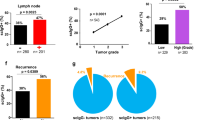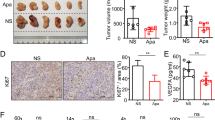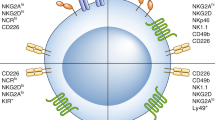Abstract
Natural killer (NK) cells are characterized by an efficient antitumor activity, and this activity has been exploited as the basis of cancer immunotherapy strategies. Interferon-α (IFN-α) is an important cytokine required for induction of the durable antitumor immune response and is an important stimulator of NK cells. In this study, to augment the efficiency of NK cell cytotoxicity to tumor cells, human IFN-α gene-modified natural killer cell line (NKL) (NKL-IFNα) cells, which could stably secrete IFN-α, were established. We investigated the natural cytotoxicity of NKL-IFNα cells against human hepatocarcinoma cells (HCCs) in vitro and in vivo. NKL-IFNα cells displayed a significantly stronger cytolytic activity against both human HCC cell lines and primary human hepatoma cancer cells compared with parental NKL cells. The increased cytolytic activity of NKL-IFNα cells was associated with the upregulation of cytotoxicity-related genes, such as perforin, granzyme B and Fas ligand, in the NK cells. Moreover, cytokines secreted by NKL-IFNα cells, such as tumor necrosis factor-α and IFN-γ, induced increased expression of Fas on the target HCC cells, and resulted in increased susceptibility of the HCC cells to NK-mediated cytolysis. Encouragingly, NKL-IFNα cells could significantly inhibit HCC tumor growth in a xenograft model and prolonged the survival of tumor-bearing nude mice. These results suggest that IFN-α gene-modified NKL cells could be suitable for the future development of cell-based immunotherapeutic strategies for hepatocellular carcinoma.
This is a preview of subscription content, access via your institution
Access options
Subscribe to this journal
Receive 12 print issues and online access
$259.00 per year
only $21.58 per issue
Buy this article
- Purchase on Springer Link
- Instant access to full article PDF
Prices may be subject to local taxes which are calculated during checkout






Similar content being viewed by others
References
Roder JC, Pross HF . The biology of the human natural killer cell. J Clin Immunol 1982; 24: 249–263.
Miller J . The biology of natural killer cells in cancer, infection, and pregnancy. Exp Hematol 2001; 29: 1157–1168.
Farag SS, Caligiuri MA . Cytokine modulation of the innate immune system in the treatment of leukemia and lymphoma. Adv Pharmacol 2004; 51: 295–318.
Hallett WH, Murphy WJ . Natural killer cells: biology and clinical use in cancer therapy. Cell Mol Immunol 2004; 1: 12–21.
Ishikawa E, Tsuboi K, Saijo K, Harada H, Takano S, Nose T et al. Autologous natural killer cell therapy for human recurrent malignant glioma. Anticancer Res 2004; 24: 1861–1871.
Iliopoulou EG, Kountourakis P, Karamouzis MV, Doufexis D, Ardavanis A, Baxevanis CN et al. A phase I trial of adoptive transfer of allogeneic natural killer cells in patients with advanced non-small cell lung cancer. Cancer Immunol Immunother 2010; 59: 1781–1789.
Tonn T, Becker S, Esser R, Schwabe D, Seifried E . Cellular immunotherapy of malignancies using the clonal natural killer cell line NK-92. J Hematother Stem Cell Res 2001; 10: 535–544.
Cheng M, Zhang J, Jiang W, Chen Y, Tian Z . Natural killer cell lines in tumor immunotherapy. Front Med 2012; 6: 56–66.
Robertson MJ, Cochran KJ, Cameron C, Le JM, Tantravahi R, Ritz J . Characterization of a cell line, NKL, derived from an aggressive human natural killer cell leukemia. Exp Hematol 1996; 24: 406–415.
Maasho K, Marusina A, Reynolds NM, Coligan JE, Borrego F . Efficient gene transfer into the human natural killer cell line, NKL, using the Amaxa nucleofection systemTM. J Immunol Methods 2004; 284: 133–140.
Smyth MJ, Hayakawa Y, Taked K, Yagita H . New aspects of natural-killercell surveillance and therapy of cancer. Nat Rev Cancer 2002; 2: 850–861.
Jiang W, Zhang J, Tian Z . Functional characterization of interleukin-15 gene transduction into the human natural killer cell line NKL. Cytotherapy 2008; 10: 265–274.
Zhang J, Sun R, Wei H, Zhang JH, Tian ZG . Characterization of interleukin-15 gene-modified human natural killer cells: implications for adoptive cellular immunotherapy. Haematologica 2004; 89: 338–347.
Ferrantini M, Capone I, Belardelli F . Interferon-α and cancer: mechanisms of action and new perspectives of clinical use. Biochimie 2007; 89: 884–893.
Belardelli F, Gresser I . The neglected role of type I interferon in the T-cell response: implications for its clinical use. Immunology 1996; 17: 369–372.
Gutterman JU . Cytokine therapeutics: lessons from interferon-alpha. Proc Natl Acad Sci USA 1994; 91: 1198–1205.
Moschella F, Bisikirska B, Maffei A, Papadopoulos KP, Skerrett D, Liu Z et al. Gene expression profiling and functional activity of human dendritic cells induced with IFN-α-2b: implications for cancer immunotherapy. Clin Cancer Res 2003; 9: 2022–2031.
Cangemi G, Morandi B, D’Agostino A, Peri C, Conte R, Damonte G et al. IFN-alpha mediates the up-regulation of HLA class I on melanoma cells without switching proteasome to immunoproteasome. Int Immunol 2003; 15: 1415–2.
Viard-Leveugle I, Gaide O, Jankovic D, Feldmeyer L, Kerl K, Pickard C et al. TNF-α and IFN-γ are potential inducers of fas-mediated keratinocyte apoptosis through activation of inducible nitric oxide synthase in toxic epidermal necrolysis. J Invest Dermatol 2013; 133: 489–498.
Moretta L, Ferlazzo G, Bottino C, Vitale M, Pende D, Mingari MC et al. Effector and regulatory events during natural killer–dendritic cell interactions. Immunol Rev 2006; 214: 219–228.
Ljunggren HG, Malmberg KJ . Prospects for the use of NK cells in immunotherapy of human cancer. Nat Rev Immunol 2007; 7: 329–339.
Chan JK, Hamilton CA, Cheung MK, Karimi M, Baker J, Gall JM et al. Enhanced killing of primary ovarian cancer by retargeting autologous cytokine-induced killer cells with bispecific antibodies: a preclinical study. Clin Cancer Res 2006; 12: 1859–1867.
Nagashima S, Mailliard R, Kashii Y, Reichert TE, Herberman RB, Robbins P et al. Stable transduction of the interleukin-2 gene into human natural killer cell lines and their phenotypic and functional characterization in vitro and in vivo. Blood 1998; 91: 3850–3861.
Zhang J, Sun R, Wei H, Zhang J, Tian Z . Characterization of stem cell factor gene-modified human natural killer cell line, NK-92 cells: implication in NK cell-based adoptive cellular immunother-apy. Oncol Rep 2004; 11: 1097–1106.
Kamath AT, Sheasby CE, Tough DF . Dendritic cells and NK cells stimulate bystander T cell activation in response to TLR agonists through secretion of IFN-αβ and IFN-γ. J Immunol 2005; 174: 767–776.
Nguyen KB, Salazar-Mather TP, Dalod MY, Van Deusen JB, Wei XQ, Liew FY et al. Coordinated and distinct roles for IFN-α, IL-12, and IL-15 regulation of NK cell responses to viral infection. J Immunol 2002; 169: 4279–4287.
Paquette RL, Hsu NC, Kiertscher SM, Park AN, Tran L, Roth MD et al. Interferon-alpha and granulocyte–macrophage colony-stimulating factor differentiate peripheral blood monocytes into potent antigen-presenting cells. J Leukocyte Biol 1998; 64: 358–367.
Luft T, Pang KC, Thomas E, Hertzog P, Hart DN, Trapani J et al. Type I IFNs enhance the terminal differentiation of dendritic cells. J Immunol 1998; 161: 1947–1953.
Santodonato L, D’Agostino G, Nisini R, Mariotti S, Monque DM, Spada M et al. Monocyte-derived dendritic cells generated after a shortterm culture with IFN-a and granulocyte–macrophage colony-stimulating factor stimulate a potent Epstein–Barr virus-specific CD8t T-cell response. J Immunol 2003; 170: 5195–5202.
Tosi D, Valenti R, Cova A, Sovena G, Huber V, Pilla L et al. Role of cross-talk between IFN-a-induced monocyte-derived dendritic cells and NK cells in priming CD8t T-cell responses against human tumor antigens. J Immunol 2004; 172: 5363–5370.
Xie Q, Shen HC, Jia NN, Wang H, Lin LY, An BY et al. Patients with chronic hepatitis B infection display deficiency of plasmacytoid dendritic cells with reduced expression of TLR9 microbes. J Infect 2009; 11: 515–523.
Sun C, Fu B, Gao Y, Liao X, Sun R, Tian Z et al. TGF-β1 down-regulation of NKG2D/DAP10 and 2B4/SAP expression on human NK cells contributes to HBV persistence. PLoS Pathogen 2012; 8: e1002594.
Robertson MJ, Ritz J . Biology and clinical relevance of human natural killer cells. Blood 1990; 76: 2421–2438.
Moretta A, Bottino C, Vitale M, Pende D, Biassoni R, Mingari MC et al. Receptors for HLA class-I molecules in human natural killer cells. Annu Rev Immunol 1996; 14: 619–648.
Soloski MJ . Recognition of tumor cells by the innate immune system. Curr Opin Immunol 2001; 132: 154–162.
Riccioli A, Starace D, D’Alessio A, Starace G, Padula F, De Cesaris P et al. TNF-alpha and IFN-gamma regulate expression and function of the Fas system in the seminiferous epithelium. J Immunol 2000; 165: 743–749.
Spanaus KS, Schlapbach R, Fontana A . TNF-alpha and IFN-gamma render microglia sensitive to Fas ligand-induced apoptosis by induction of Fas expression and down-regulation of Bcl-2 and Bcl-xL. Eur J Immunol 1998; 28: 4398–4408.
Li Z, Tuteja G, Schug J, Kaestner KH . Foxa1 and Foxa2 are essential for sexual dimorphism in liver cancer. Cell 2012; 148: 72–83.
Sells MA, Chen ML, Acs G . Production of hepatitis B virus particles in Hep G2 cells transfected with cloned hepatitis B virus DNA. Proc Natl Acad Sci USA 1987; 84: 1005–1009.
Grund EM, Muise-Helmericks RC . Cost efficient and effective gene transfer into the human natural killer cell line, NK92. J Immunol Methods 2005; 296: 31–36.
Acknowledgements
This work was supported by grants from the National Natural Science Foundation of China (81102209, 30972962) and the Ministry of Science and Technology of China (2012AA020901; 2012ZX10002-014; 2006CB504303; 2007AA021109).
Author information
Authors and Affiliations
Corresponding author
Ethics declarations
Competing interests
The authors declare no conflict of interest.
Additional information
Supplementary Information accompanies this paper on Gene Therapy website
Supplementary information
Rights and permissions
About this article
Cite this article
Jiang, W., Zhang, C., Tian, Z. et al. hIFN-α gene modification augments human natural killer cell line anti-human hepatocellular carcinoma function. Gene Ther 20, 1062–1069 (2013). https://doi.org/10.1038/gt.2013.31
Received:
Revised:
Accepted:
Published:
Issue Date:
DOI: https://doi.org/10.1038/gt.2013.31
Keywords
This article is cited by
-
The effects of Sorafenib and Natural killer cell co-injection in combinational treatment of hepatocellular carcinoma; an in vivo approach
Pharmacological Reports (2022)
-
Type I interferon-mediated tumor immunity and its role in immunotherapy
Cellular and Molecular Life Sciences (2022)
-
Cellular based immunotherapy for primary liver cancer
Journal of Experimental & Clinical Cancer Research (2021)
-
Combinational immune-cell therapy of natural killer cells and sorafenib for advanced hepatocellular carcinoma: a review
Cancer Cell International (2018)
-
Natural killer cells in hepatocellular carcinoma: current status and perspectives for future immunotherapeutic approaches
Frontiers of Medicine (2017)



